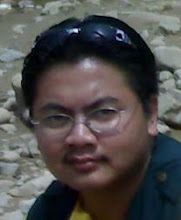
Generally, the trimmings and embroidery on the Kadazan costume are simple and dignified in comparison with other ethnic groups. The men’s jacket and trousers bear some Chinese influence. There are three different styles of blouses for the women. One is a blouse with short sleeves worn by young ladies. Another is a blouse with ¾ sleeves worn by middle-aged ladies for daily or casual use. The third one is worn by elderly women and female ritual specialists/priestesses during ceremonies.
Textile
Basic material: Black commercial fabric: silk or velvet for ceremonial occasions, cotton (vernacular tuit) for daily wear.
Costume of Women
sinuangga' Blouse with short sleeves and U-neck worn by younger women. Sober embroidery along the opening for head and arms, and along the seams at the sides and along the middle of the back: red, yellow and cream cotton yarn. Main stitches: sinusuk bulus (chain stitch), tantop (flanel stitch). A flanel stitch technique is also used to make binuunsi', a narrow band of needle weaving in red and yellow looking somewhat like shoelace.
Betawi buttons are looped through a string on the inside. This way, the valuable buttons can be used for various blouses. Betawi buttons used to be fixed all the way up to the neck for ceremonial occasions and half way up from the lower end of the blouse for daily wear. Nowadays, this appears not to be differentiated. The buttons are tied together from the top down to the bottom of the blouse with a cotton thread.
The gold-plated silver Betawi buttons were a status symbol for the Kadazan Penampang. If one could afford a set of thirty buttons (sonsolobuan), one was considered a wealthy person.
sinompukung Blouse with 3/4 sleeves. No embroidery. Usually worn over the sinuangga' like a jacket when the wearer goes out of the house, such as to visit a friend. Nowadays, the sinompukung is often embroidered and worn by older women as a blouse instead of as a jacket as in the olden days.
kihongon Blouse with long sleeves, worn by elderly women and female ritual specialists/priestesses or Bobohizan during ceremonies. The embroidery is similar to the one on the sinuangga'.
simis "Chemise"—a white cotton underblouse. Sometimes just a white kerchief is tucked into the U-neck.
tapi' Long cylindrical wrap-skirt, formerly of plain black cotton. Nowadays often enlivened with siring: gold trimming, running over the hips, in front of the skirt, crossed by another band of trimming from the waist down.
Accessories:
himpogot Silver "dollar" belt. A maximum of three are used depending on personal wealth, one around the waist and the other two above and below the tangkong.
tangkong Hip-belt of approximately 84 embossed brass rings on rattan strings (hindavog). Three tangkong are worn together, alternately strung with red (hindagang), black (initom) and red rattan strings for unmarried girls and all black for married women. The string is always "bare" somewhere at the back to avoid asampon (lack of breathing space). Later in life the tangkong are stretched out for various reasons, one of which is so that it is easier to carry a back basket.
Titimbak Hairpin to decorate and fasten the hairbun.
Tiningkokos Brass or silver spiral bracelet.
Gohong Brass or silver bracelets.
Hamai Necklace.
Simbong Earrings.
paun Brooch of gold coin(s).
siga do bobohizan Worn during rituals/ceremonies by the Bobohizan. It is an ornate headdress that is made from feathers of peacocks or turkeys. The plumage is tightly packed together and sewn onto a wide band of cloth. The feathers form the support and shape of the headdress, which when seen from the front is almost wholly covered with the cloth that fans outwards from the head. From the back however, these feathers are almost wholly visible. The wide band of cloth to which the feathers are sewn is decorated with multicoloured applique, embroidery and beads. Andavi do tandaa' or long-tailed feathers of roosters are also sewn at the front of the cloth. The tip of each of these feathers is tied with several small pieces of colourful cloth. From the lower part of both sides of the headdress are sewn several long loops of coloured beads which hang down to the front/chest. The headdress is secured/tied by cloth at the back of the head. The headdress is approximately one and a half feet in height.
Husob A colourful cloth worn by the Bobohizan over one shoulder and across the body. Usually two husob are worn together cries-crossing each other.
Costume of Men
Gaung Long-sleeved shirt without embroidery. Nowadays it is decorated with gold trimming and gold buttons.
Souva Black trousers with wide indigo-blue waistband. Gold trimming on the seams along the hips for modern trousers.
Kaking or toogot Black waist sash.
Siga Headcover of handwoven kain dastar, folded or twisted in a number of distinctive ways: Hinopung (hopung = python): twisted model Kinahu' (kahu' = potholder): folded model Sinimbitan or tinahanuk: only one small corner sticking out.
Tupi' sinikat Circular hat of sturdy string made with the coil and tie technique to support the siga.

No comments:
Post a Comment